#piscataqua river
Explore tagged Tumblr posts
Text





[So I'm here in downtown Portsmouth, New Hampshire, about a third of a mile from the Piscataqua River to check out a joint where a chef from New Jersey and a chef from Connecticut, well, they migrated north and opened up a not-so-common deli.]
#s25e07 burgers buns and bagels#guy fieri#guyfieri#diners drive-ins and dives#downtown portsmouth#new hampshire#piscataqua river#new jersey#mile#joint#chef#connecticut#deli
6 notes
·
View notes
Text
instagram.com @thequalifiedcaptain
There has been a lot of whales up in Portsmouth NH and even a couple inside the Piscataqua river mouth. Watch out for the big pogie schools. Whales can't see through them, and it can lead to this. These guys were simply fishing when this happened. Everyone was ok.
85 notes
·
View notes
Text

Fishing Fleet off Fort Constitution (formerly Fort William and Mary), at the mouth of the Piscataqua River, Portsmouth, New Hampshire, by Franklin D. Briscoe, 1876
53 notes
·
View notes
Text




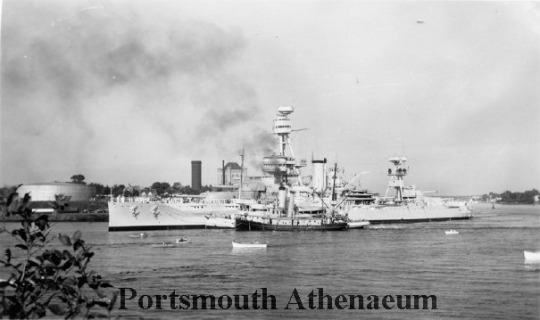
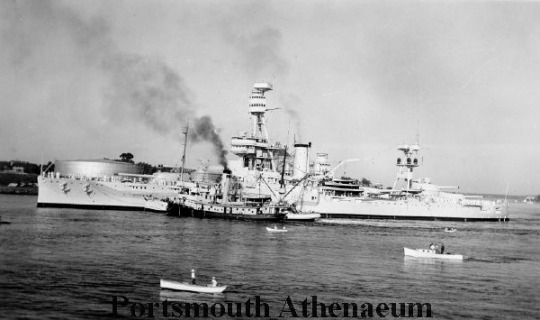
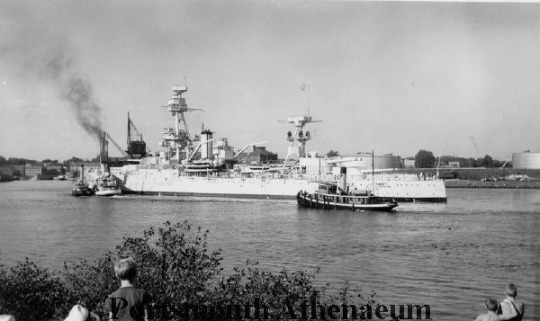
USS TEXAS (BB-35) steaming up the Piscataqua River to the Portsmouth Naval Shipyard (PSNY) in Kittery, Maine.
Photographed by Alvah C. Card, from Peirce Island in Portsmouth, NH.
Date: August 5, 1939
Portsmouth Athenæum: P0053_178, P0053_179, P0053_180, P0053_181, P0053_182, P0053_183, P0053_184
#USS Texas (BB-35)#USS Texas#New York Class#Battleship Texas#Dreadnought#Battleship#Warship#ship#Fort Point Light#Portsmouth Harbor#New Castle#New Hampshire#United States Navy#U.S. Navy#US Navy#USN#Navy#east coast#August#1939#interwar period#my post
12 notes
·
View notes
Note
13. Dancing for CrossxEvelyn
Aaaaand
3. Holding hands for CrossxCharon (because I just know antics will happen with them 🤣🤣)
((Also I joined you Discord server 👀👀👀))
✨OTP ASKS✨
(Ohmygawd I ugly snorted at the holding hands prompt, that's some good shit 😂)
Dancing
(Cross x Evelyn)
Knock knock
Lydia lifted her head from the new schematic she was poring over, a singed eyebrow slowly rising in surprise at the sight she saw. Cross was standing just in the doorway of her workshop, dressed to the nines in a tailored dark green suit and shined black dress shoes.
He sheepishly held out a bowtie. "Ya mind? Kind of hard without all my fingers."
"Wow," she said as she wiped her greased hands on a rag. "You clean up nice." She pointed with her elbow to the suit as she quickly scrubbed her stained face. "Where in the world did you get something like that?"
Cross looked down at his formal attire, running a hand down the sleeve of his dinner jacket. "Let's just say it was worth the price I paid."
She dropped her towel and walked over, taking the bowtie in her hands and fumbling with it under his collar. "So, what's the occasion?"
He kept his chin raised slightly as she tightened the finishing touches. "...it's just somethin' I've been wantin' to do."
Lydia gave him a sly look. "Does Evelyn even know?"
"Nope."
She smoothed the bowtie and stood back to assess her due diligence before her face pinched together. “Please tell me you aren't taking her to Scuzzy’s."
He chuckled. "I bought the place last week and had it cleared out.”
Her jaw dropped. “You what?! How did you manage that?! How much did that even cost?! Is that what the guys have been doing this whole time?!"
His bony fingertip settled under her chin and clicked her mouth shut. He winked. "Helps to have some favors finally paid."
"So, wait, hold on...we own a bar?! Scuzzy's?!"
Cross patted her shoulder, slightly jostling her to the side. "You can have some fun with it when we're done, and only when we're done. Capeesh?"
She grinned. It was good to have the old Cross back.
---
Evelyn twirled in a circle, the navy blue sequins of her dress glittering diamonds along the wall. She then tapped the toe of her cream-colored heels a few times before looking upward and flashing the ghoul a dazzling smile.
"I love it. How did you know my size?" she questioned, snugging an arm around his as he opened the door of their room.
Charon softly snorted, grabbing her ass with one huge palm and giving a light squeeze.
They left the compound and walked under a rare, clear night sky, the stars just above their heads twinkling the ones on her dress. Evelyn shrugged into the merc's bomber jacket a little more closely to ward off the faint chill as they crossed the bridge separating old state lines, the Piscataqua River lapping beneath their feet and the soft lights of Scuzzy's on the riverbank heralding their destination.
"It's so quiet," she noticed, her breath fogging the air. She turned her head to his. "Do you think he'll be back soon?"
Charon nodded. "It is a simple package. I am sure he is on his way."
"Did he tell you what kind? He wouldn't tell me."
The ghoul playfully nudged her with his elbow. "He did."
They continued, her heels tap tap tap down the road as she waited for him to continue, but when it appeared he would take Cross' secret with him to the grave, she huffed and muttered to the side, "It's something totally perverted, isn't it?"
Charon halted, making her freeze in place. She blinked as he took his arm away to pull out a scarf that he then put around her eyes.
"Um, what are we doing?"
"It is a surprise," was all he rumbled, and then he carefully tightened it before leading her blindly along. "Do not peek."
The tips of her ears slightly perked up as she heightened her hearing for any clue as to what was about to commence. A door opened. The soft play of music. The door creaked closed. Footsteps. A mumble of words, too garbled and low for her to hear. More footsteps. The door again. And then-
Silence.
The scarf was carefully untied and lifted away, and she blinked at the new world she had been pulled into.
She gasped, "Wow."
Long gone was the dive bar known as Scuzzy's, the only joint this side of the water that was reputable for its distilled beers and drunken brawls. Nearly every piece of furniture had been initiated as an improvised weapon and accordingly destroyed and duct-taped back together. Mercs of all shapes, sizes, contracts, skills, and morals had come to Scuzzy's to pay their tributes with a baptized black eye and missing tooth, and now, all the blood, shit, piss, and cigarette stains had been washed away and sanded down to be reclaimed to its former Pre-War glory.
The floor was adorned with plush rugs, the furniture upholstered in velvet. The bar counter was no longer an old ship's timber nearly crumbling apart from musty wood rot, but was replaced by a marble slab that had been cut and polished. Strings of lights illuminated the once grungy, dim corners, and a pristine jukebox played Nat "King" Cole in the corner.
"I don't want to see tomorrow,"
"Hey, baby," a voice rasped behind her.
"Unless I see it with you."
She turned, her eyes growing wide and her cheeks burning warm and her heart beating much too fast behind her ribs.
"Wow," she repeated, breathless.
Cross was stunning. She drank in every drop of him, from head, to toe, every inch of well-defined muscle nicely fitted underneath the rich color of a dark green that she had only seen in her dreams of misty, old forests and their scented pines that dripped rain.
He scratched at his brow. "You ain't havin' another stroke, are ya?"
The quip blushed a shy smile on her lips, and she meekly clasped her hands together as she softly said, "You look very handsome."
"Yeah?" He grinned, fidgeting his hands in his pant pockets.
It was then that she realized he was flustered, too. It sunk a wet heat in the pit of her belly, and she nervously wrung her fingers together.
"Yeah."
He stepped forward, closing the space between them, and rubbed a hand over his bald head as he let loose a deep breath. "You're the most beautiful fuckin' woman I've ever laid eyes on," he garbled somewhat awkwardly. He then cleared his throat, shaking his head as he tried again. "Do you, uh, want a drink- shitsorryno, I mean-"
She took his hand and gave it a squeeze. "I would love a Nuka-Cola."
The merc nodded vigorously, pulling her along behind him as they made for the bar counter.
"Ya want to sit at the bar, or-?" he asked again, his rasp still unsure.
His endearing bashfulness exploded butterflies in her stomach as she pointed to a stool.
"Right there is okay."
She claimed her seat as he walked around to the front and unbuttoned his jacket to shrug out of. Her eyes glued to the swell of his biceps and the width of his forearms as he rolled up his sleeves to his elbows, the ghoul completely unaware of her ogling as he plunked a few ice cubes into a glass and popped the cap off her choice of soda.
He set the fizzing pops before her, raising a brow muscle at the hint of drool dribbling from the corner of her lips. "Ya that thirsty?"
Evelyn stupidly blinked as she wiped at her mouth and swiped at her drink, taking a sip before she could say something unintelligible. Forming a single, coherent thought seemed futile as he set an arm down to lean close to her, the fabric of his shirt pulling tight and the suspenders over his broad shoulders stretching and by God she could even see the bulge in his pants-
She choked on her drink, spewing soda to the side as she coughed and very ungracefully gargled like a warthog to clear her lungs.
Cross tapped his knuckles on the counter and took her iced drink away. "Ya want to dance?"
An inhuman sort of sound left her throat.
"...that a yes?"
She nodded after smearing sticky soda all over her lips, and he came around the counter to gently disrobe his bomber jacket from her shoulders. He set it aside, lightly tracing his fingertips down the naked skin of her spine.
"C'mere, baby."
She took his offered hand, and he pulled her towards him, gently circling them to the middle of the room and swaying under the soft light. She stepped on his foot.
"You'll one day get it," he rasped, then continued with a tease, "maybe 'fore the next bombs drop, if we're lucky."
She rolled her eyes and leaned into him, listening to the deep, smooth beat of his heart pounding in his chest as he expertly twirled them around in tempo to a mellow tune.
His hand guiding her at the small of her back crept down a bit further to grope her ass. "Ya like how we did the place?"
"It's beautiful. Is it yours, now?"
"I got it for you." When she instantly flipped her head up to stare at him, he chuckled. "Goin' to need a new name."
She tapped a finger to her lips before breaking out in a wide smile, and before he knew it, he was in love with her all over again.
"The Crossroads," she decreed.
Cross rasped thickly as he stared at the perfect view down the front of her dress, "Hmm. Got a nice ring to it."
Evelyn giggled as she pulled him down by the collar, saying with a tinge of husk, "Damn right it does."
And it was christened with a kiss.
Holding Hands
(Charon x Cross)
“Oh my God,” Evelyn breathed out as she pointed to the Pre-War kiddie's marvel just out of reach. ��What the fuck is that?!”
Cross came around the side, shoving his hands deep in his bomber jacket pockets and snapping some bubbles from the gum in his mouth. “Huh. Ain’t never thought I’d see it in person.”
The neon-green ball of ooze set high on its pedestal in the middle of the dilapidated toy store glowed with all the promise of a child’s wonderment and delight. Faded posters plastered on a board that advertised the (slightly) radiated slime beamed pictures of smiling children…and a five-page, very finely printed, warning disclosure.
Cross scratched at his brow as he squinted at the barely legible liability statement, mumbling to himself, “…loss of vision, loss of limbs, addition of limbs (heh), vomiting blood, uncontrollable diarrhea-" He paused for a moment before rasping without looking up, “What’d ya have for lunch again?”
No answer, and he raised his eyes.
Evelyn had bypassed the ‘employee-only’ stanchions and was on the tips of her toes, going to make a grab for the gelatinous (not) repurposed nuclear waste.
“Hey!” Cross barked, and she froze mere inches from the ball of slime as he scolded her, “Fuck did I just say?”
Her hands instead came to her sides as she crossed her arms in a pout. “What?! It wouldn’t be here if it was that dangerous.”
“You shittin’ me?” he rasped as he pointed a bony fingertip to the piles of skeletons lying ominously around. “That ain’t too much of a fuckin’ clue for you, Space Cadet?”
Her eyes squinted slightly, the insult not sticking the landing. “Space Cadet?”
A thud of heavy boots from deeper within the cavernous remains of the store announced their third party member. Charon took in the scene and simply sighed.
“You are lucky you are immune,” was all he said.
Evelyn curtly shrugged and turned to eye her prize again, but the merc growled as he stepped forward, a human skull crushed to dust under his boot.
“I ain’t takin’ any chances,” he said firmly- no ifs, ands, or buts.
The frown of her lip dipped a little further, venturing from peeved to disappointed.
“But it looks cool,” she said sadly.
Cross’ glower slowly crumbled into indecisiveness under the pressure of her pleading puppy look. The big eyes and the quivering lip somehow seemed to always slip past his defenses, and he was soon standing before the pedestal to grab at The Ooze!
“Damn lucky is right,” he muttered under his breath as he placed a hand over the thing. It immediately swallowed his fingers, his palm, and all the way down to his wrist with a sickening slurp! He grimaced at the icky sensation of the slime having devoured his entire right hand, and he held it up and wiggled it in the air, unable to unlatch it.
“What’s it feel like?! Can I try?!” She began to extend her wiggling fingers for it, but he simply lifted his arm to keep her out of reach. “Hey!”
“Not till I know it’s safe,” he growled.
She scoffed, “Oh please, it’s a children’s toy!”
“You would be surprised,” Charon rasped flatly as he came to make his own inspection of The Ooze!
The merc held it over for him to take, and the ferryman dipped a few fingers in the squelching slime to be completely enveloped. He pulled, and Cross grunted as he was nearly tipped over.
"Just take the damn thing," Cross growled.
The muscle of Charon's brow twitched as he gave a second attempt, to only receive the same outcome.
He snarled as he yanked with more force, “I am trying.”
The merc stumbled into the man as he partially swept him off his feet, and together their captive hands interlaced at the fingers. Both ghouls shrugged the other one off and looked down at the slime, before raising their eyes simultaneously to share a single thought of I don't know what we expected. They then glanced at Evelyn just standing in her spot, her barely contained laughter threatening to burst her at the seams.
“You passin’ gas over there?” Cross rasped dourly at her flushed face and cheeky smile.
“Oh my God!” she cackled, unable to contain herself any longer as she burst wide open with a bellyful of laughter. She wheezed, wiping the tears from her eyes as she began to walk away, “Where’s that camera?!”
Charon took a step forward just as Cross took his own in the opposite direction, and both their shoulders practically dislocated from their sockets as they refused to yield to the opposing force. The ferryman whipped a glare around just as Cross snarled at him.
"Hey!" Evelyn called over from a side room. "Think I found something."
Cross grumbled to himself, "Thank Christ."
Their smoothskin came bumbling over with a sheet of yellowed paper in her hand, waving it in the air like a battle flag. "It says on this to 'Please see the manager in the event of contact with The Ooze!'"
Charon pinched his brow as Cross directed his smoldering glower to her instead.
The merc gave a quick look around, his rasp dripping with sardonic sarcasm. "Don't think he's in today."
"Do you think I'm stupid?" she bristled, and when he said nothing to refute it, she scoffed and tossed the paper over her shoulder to stomp off. "Have fun jacking each other off for the rest of your lives."
"Evelyn."
"Yeah, yeah," she snarked as she took to the stationary escalator, stomping to the upper levels without looking back. "I remember seeing the manager's office somewhere up here. I'll be right back."
The ghouls waited a few moments in silence before the merc sighed and indicated with his chin to a bench against the wall. With coordinated steps, they both came to sit beside each other, their fingers still interlocked together in the dense mass of goop.
Cross wormed around his jacket for a pack of bubblegum, popping two pieces free. "Might be here awhile."
Charon took the stick of stale gum. "I sincerely hope not."
Cross pocketed the carton away and chewed, blowing a few bubbles for a moment. They quietly indulged themselves with their treat and private thoughts, and then Cross titled his head to the side to peer up to the second-floor landing. There was no sight, or sound, and he grumbly sighed and leaned back.
"Got to take a shit," he grumbled to himself.
Charon shifted in his seat, rasping just as lowly, "...I as well."
Cross cupped his free hand around his mouth and yelled, "Hey! Fuck you doin' up there?!"
There was a sudden great big BOOM, and both ghouls jumped to their feet and whipped out their weapons, making a race for the stairs when their legs tangled together in an uncoordinated tango. They collapsed to the floor in a heap of limbs, skittering guns, and pained grunts. Cross coughed while Charon lifted himself partway with his free hand, and then they both blinked. The merc was pinned beneath the slightly bigger ghoul, Charon's thighs straddling him at the hips and their heavy breathing washing over their faces.
A thundering of feet made them quickly glance up. Evelyn had raced down the stairs, pausing for only a very brief moment to take in the scene.
"It sure as hell ain't what it looks like," Cross rasped.
A flutter of...disappointment, downturned her lips and smoothed her brow, before she seemed to have remembered the dangers coming for them and proceeded to scurry for the safety of outside, leaving the duo in their rather intimate position.
Cross yelled after her, "Hey! Evelyn!" He then growled as he put his weight in shoving the other ghoul off, "Get the fuck off me!"
They both awkwardly stood, but not without a tangle of buckles and snapping of leather straps and the laces of their boots snagging one another. Something skittering whipped their heads on a dime, and they both slowly followed the journey of a very sizeable glowing radroach crawling to the base of their feet.
Its antennas twitched, once, twice, and then it very cautiously stood on its hind end and wiggled its mandibles for The Ooze!
The ghouls shared a look.
"...do you think she will come back?" Charon rasped quietly so as not to scare their mutated friend.
The radroach continued to nibble away as they sat on their bench and waited with tedious patience for it to free them from their 'get-along' slime.
Cross squinted his eyes and shrugged his shoulders. "Probably back at Kittery by now." He then twitched as he felt the radroach chew on his index finger. "Watch it, ya little bastard."
Charon snorted. "You are probably right."
More silence, and then the merc turned his head.
"We're never tellin' anyone 'bout this."
"Agree."
#otp prompts#CrossxEvelyn#CharonxCross#OC: Cross#OC: Evelyn#charon fallout#fallout ghoul#thanks Void!#these were nice and fun to do
3 notes
·
View notes
Text

Sunshine in the rain = compass flower, spirea, daylily and Piscataqua River.
"In ancient times... solitude was used as an oracle, as a way of listening to the inner self to solicit advice and guidance otherwise impossible to hear in the din of daily life." ~Clarissa Pinkola Estes
The Heirloom Gardener John Forti
7 notes
·
View notes
Photo

Are you considering moving to Portsmouth, New Hampshire? If so, you're not alone! This charming coastal city has become a popular destination for people from all walks of life. In this blog post, we'll Let's explore five reasons why people love living in Portsmouth, New Hampshire. Rich History Portsmouth, New Hampshire, is a city that's steeped in history. Founded in 1623, it's one of the oldest cities in the United States. Visitors and residents alike can immerse themselves in the city's history by visiting the Strawbery Banke Museum, which features restored 17th-century buildings and exhibits that bring the city's past to life. Coastal Beauty Portsmouth is situated on the Piscataqua River, which flows into the Atlantic Ocean. The city's location makes it a popular spot for boating, fishing, and other water-based activities. The nearby beaches, including Hampton Beach and Rye Beach, are also popular destinations for residents and visitors alike. Vibrant Arts and Culture Scene Portsmouth is home to a thriving arts and culture scene. The city is home to numerous galleries, museums, and theaters, including the Music Hall, which is one of the oldest operating theaters in the United States. Residents can also enjoy various festivals throughout the year, including the annual Portsmouth Maritime Folk Festival and the Prescott Park Arts Festival. Outdoor Recreation Portsmouth is a great place for outdoor enthusiasts. The city boasts several parks and green spaces, including Prescott Park and the Great Bay National Wildlife Refuge. Residents can also enjoy hiking and biking on the many trails in the area. 🚲⛵️🛶🚉🏖 Portsmouth, New Hampshire, is a wonderful place to live. Its rich history, coastal beauty, vibrant arts and culture scene, outdoor recreation, and a strong sense of community make it a popular destination for people from all over. #annandjim #lifeontheseacoast #portsmouthnh https://ift.tt/T7McVXr https://instagr.am/p/CrlQvdTLZqV/
3 notes
·
View notes
Text
Traveling Across the USA New Hampshire
Portsmouth on the Piscataqua River A city in the US state of New Hampshire The New England state of New Hampshire is home to the lovely White Mountains with Mt. Washington being the highest peak in the region. The White Mountains are home to moose and black bears and include part of the Appalachian Trail. Portsmouth is a port city on the Piscataqua River. Get to know Portsmouth by walking…

View On WordPress
0 notes
Text

Celebrate the scenic beauty of New Hampshire’s Piscataqua River with this handcrafted wooden map! 🏞️ A beautiful addition for anyone who loves nature, boating, or coastal life, capturing the details of the river's topography.
#PiscataquaRiver#NewHampshire#HandcraftedArt#WoodMap#CoastalLife#PortsmouthNH#NewingtonNH#TopographicArt#NewEnglandNature
0 notes
Text
Explore Kittery, Maine on a Budget: 6 Free Things to Do
Kittery Maine is the ideal destination for travelers seeking to immerse themselves in the breathtaking coastal scenery in their budget. Known for its rich maritime heritage and stunning New England charm, Kittery offers a unique blend of historic landmarks, picturesque beaches, and vibrant local culture. In this blog, the Maine Travel Guide will walk you through how to explore Kittery on a budget, highlighting incredible free activities that capture the essence of this coastal gem.

1. Explore Fort McClary State Historic Site
Dive into the rich history of Kittery by visiting Fort McClary, a well-preserved historic military site. Enjoy walking around the old fortifications while soaking in stunning views of the coastline.
Highlights of Fort McClary:
Historic Significance: Fort McClary has protected the approaches to the Piscataqua River for over 275 years, playing a key role in Maine’s defense.
Unique Architecture: The hexagonal blockhouse at Fort McClary is one of the last of its kind in Maine.
Scenic Views: Visitors can enjoy stunning views of the nearby Whaleback Light and Portsmouth Harbor Light.
2. Stroll Through Kittery’s Famous Outlet Malls
While window shopping won’t cost you a thing, Kittery Maine famous outlet malls are a great place to explore designer brands and enjoy the lively atmosphere.
Highlights of Outlet malls:
Great Deals: Outlet malls offer discounted prices on a wide range of designer and popular brands, making it a shopper’s paradise.
Variety of Stores: Shoppers can explore a large selection of stores, from clothing and accessories to home goods and electronics.
Fun Atmosphere: The lively environment of outlet malls makes them ideal for both shopping and enjoying a day out with family or friends.
3. Visit the Kittery Art Association
Art lovers can enjoy free gallery exhibitions showcasing the talents of local Maine artists at the Kittery Art Association.
Highlights of Kittery Art Association:
Community-Focused: The Kittery Art Association is a nonprofit organization dedicated to promoting knowledge and appreciation of the arts within the community.
Exhibition Opportunities: It provides local artists a platform to showcase their work through various exhibitions held throughout the year.
Established Legacy: Founded in 1958, the association has a long-standing history of supporting the arts in Kittery.
4. Hike the Trails at Rogers Park
Spend a day exploring the serene beauty of Rogers Park, highlighted in the Kittery Maine Guide as a tranquil nature retreat. Offering free hiking trails, it's the perfect spot for a leisurely walk while immersing yourself in the picturesque scenery of Kittery Maine.
Highlights of Rogers Park:
Nature Trails: Rogers Park offers peaceful hiking trails perfect for walking and enjoying nature.
Pet-Friendly: It’s a great spot for visitors with pets, as the park is dog-friendly.
Scenic Views: The park provides stunning natural landscapes, making it ideal for outdoor photography and relaxation.
5. Explore Fort Foster
Discover the natural beauty of Fort Foster on Gerrish Island, where you can hike along the trails, explore the beach, and even visit the old military bunkers.
Highlights of Fort Foster:
Scenic Views: Fort Foster offers stunning ocean views, perfect for photography and relaxation.
Historic Forts: Explore the old military fortifications that date back to the early 20th century.
Recreational Activities: The park features beaches, playgrounds, picnic areas, and hiking trails for a fun day out.
6. Walk Along the Kittery Point Harbor
Take in the breathtaking waterfront views and soak up the fresh ocean air with a stroll around the picturesque Kittery Point Harbor.
Highlights of Kittery Point Harbor:
Historical Significance: Kittery Point Harbor traces its roots back to 1623, making it one of the oldest seafaring settlements in the area.
Scenic Beauty: The harbor offers beautiful waterfront views, ideal for visitors looking to enjoy peaceful coastal scenery.
Boating Access: Kittery Point Harbor features a public wharf with an adjacent boat ramp, making it a popular spot for boaters.
Kittery Maine offers a wealth of complimentary experiences for visitors seeking to soak in the scenic coastal charm of Maine, all while keeping all things in their budget. Wandering through historic landmarks like Fort McClary and Fort Foster to explore the scenic nature trails that wind through the area’s stunning landscapes, Kittery offers endless opportunities for discovery. Visitors can stroll along the picturesque harbor, visit art galleries, and enjoy the town’s rich history that dates back to the early 1600s.
FAQ’s
1. What can visitors do at Fort McClary?
Visitors can walk through the fort’s historic structures, take in the beautiful views of the Piscataqua River, and enjoy picnicking or exploring nearby trails.
2. Are there any free activities at the Kittery Outlet Malls?
A: While shopping itself isn't free, you can enjoy window shopping, browsing designer stores, and experiencing the lively atmosphere without making a purchase.
3. Are there any free art workshops or community programs available in Kittery Art Association?
The Kittery Art Association offers free or low-cost community programs, including art shows and educational workshops, making it accessible to everyone.
4. Is Rogers Park dog-friendly?
Yes, Rogers Park is a dog-friendly location where visitors can walk their dogs on the trails, making it a great spot for pet owners.
5. Is Fort Foster a good spot for nature lovers on a budget?
Absolutely! Fort Foster offers beautiful nature walks, wildlife spotting, and coastal landscapes, making it ideal for budget-friendly outdoor experiences.
6. Can I go boating at Kittery Point Harbor without a personal boat?
Yes, Kittery Point Harbor offers boat rental services and public boat facilities, perfect for exploring the harbor even if you don’t own a boat.
0 notes
Text




[The only thing wrong with that dish, yet, there’s a woman he’s connected with, Ushikawa groaned. So I'm here in downtown Portsmouth, New Hampshire, about a third of a mile from the Piscataqua River]
#s25e07 burgers buns and bagels#guy fieri#guyfieri#diners drive-ins and dives#downtown portsmouth#new hampshire#piscataqua river#thing#dish#woman#ushikawa#third#mile
3 notes
·
View notes
Link
Tragedy Strikes: Fatal Shooting on New Hampshire-Maine Bridge Linked to Homicide In a shocking turn of events, authorities are investigating a tragic incident that unfolded on the Piscataqua River Bridge, a vital link between New Hampshire and Maine. Early Thursday morning,...
0 notes
Text
this week for my job i had to drive the entire coastline of new hampshire for several days in a row, like from the merrimack river to the piscataqua river. the whole new hampshire coastline. so this is the playlist I made to listen to while doing that.
1 note
·
View note
Text
The Gulf Of Maine Is Warming Fast. What Does That Mean For Lobsters—And Everything Else?
National Geographic photographer Brian Skerry has been diving in the Gulf of Maine for more than 40 years. After learning these waters were a harbinger of climate change, he set out to document the rapid shift and its ripple effects.
— Photographs By Brian Skerry | As Told To Anna Peele | May 14, 2024
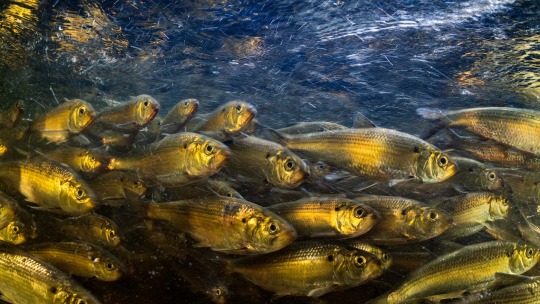
A large school of alewives migrates upstream through Mill Brook, an inland stream with waters that eventually flow into the Gulf of Maine. These fish live in the ocean but return to fresh water to spawn. Once depleted, the species rebounded after dam removals in the area, and now feed a variety of other fish, birds, and mammals.
The bounty of the Gulf of Maine. The sea within a sea, as it’s often called, is a body of water that extends 36,000 square miles along the eastern seaboard of North America, from Cape Cod, Massachusetts, to New Brunswick, and encompasses the coastlines of New Hampshire, Maine, and Nova Scotia. Indigenous Americans who have lived in this region for more than 12,000 years learned the gulf’s natural rhythms and sustainably harvested its rich waters. Europeans who began to settle in the area in the 15th century recorded tales of an endless abundance, with cod that measured up to five feet long. Before the American Revolution began, giant lobsters and thick schools of fish would have had a front-row seat to the Boston Tea Party.
I think of the Gulf of Maine as having been created from a perfect recipe that required a precise series of ingredients and steps. There is a robust watershed with many rivers flowing into the sea and a unique blend of currents that bring and mix nutrients, including upwelling from the continental shelf, the Gulf Stream, the Labrador, and counterclockwise coastal currents. Because of the Gulf of Maine’s geographic location in a temperate zone, a seasonal stratification that separates water into warmer and cooler layers also occurs here. The result has historically been the proliferation of life. But things have changed.
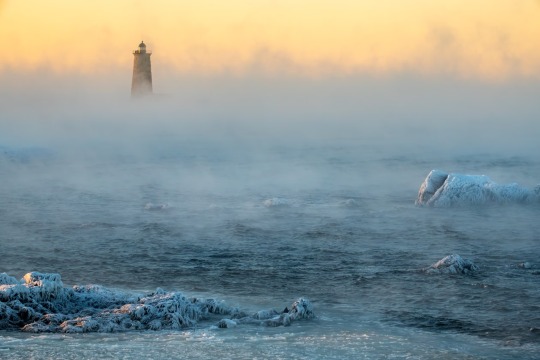
Sea smoke rises over the ocean near Whaleback lighthouse at the mouth of the Piscataqua River in Kittery, one entrance to the Gulf of Maine. This fog forms when very cold air moves over warmer water, mixing with a shallow layer of warmer air above the ocean’s surface. As the warmer air cools, the excess vapor condenses.
Over the centuries, the rise of sophisticated commercial fishing fleets has led to a steep decline in marine wildlife. Atlantic cod, its supply once believed to be inexhaustible, is now at one percent of colonial levels. So within just a couple hundred years, we have removed 99 percent of this species from the region. In the past four decades spent exploring these waters, I have witnessed how such declines have made the ecosystem weaker and more vulnerable in ways I never imagined.
I grew up in a working-class town in Massachusetts, about 40 miles from the ocean, but my parents would take me to the beach in summertime. As early as I can remember, I fell in love with the sea. My dream was to be an ocean explorer and photographer, sharing all that I saw and learned. In my 26 years of capturing images for National Geographic, I’ve been fortunate to work on all seven continents and in nearly every marine ecosystem from the Equator to the poles. I have always felt, however, that the ocean suffers from a bit of a curse in that its exterior hides what lies beneath—both the exquisite natural beauty and the ongoing devastation.
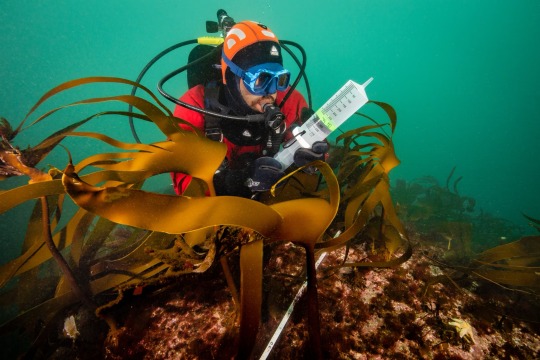
Marine ecologist Douglas Rasher collects water samples from a kelp forest near Winter Harbor. Along the southernmost coast of Maine, these essential marine habitats appeared healthy a few years ago but are now vanishing.
That’s why the most crucial part of my job doesn’t really happen in the water. Before each expedition, I first dive as deeply as possible into the world of researchers who dedicate their lives to understanding marine animals and their relationship to the environment. Only then can I bring the right visual context. Whether they’re images of orcas using different feeding strategies in order to share the rich complexity of whale culture or photos of a five-day-old harp seal pup falling through thin ice to show how deadly our warming planet has become for some species, my goal is to help people understand what’s happening in our world.
In Hot Water
Parts of the Northwest Atlantic, especially the Gulf of Maine and the Labrador Sea, have been heating up faster than 99 percent of the World’s Oceans.
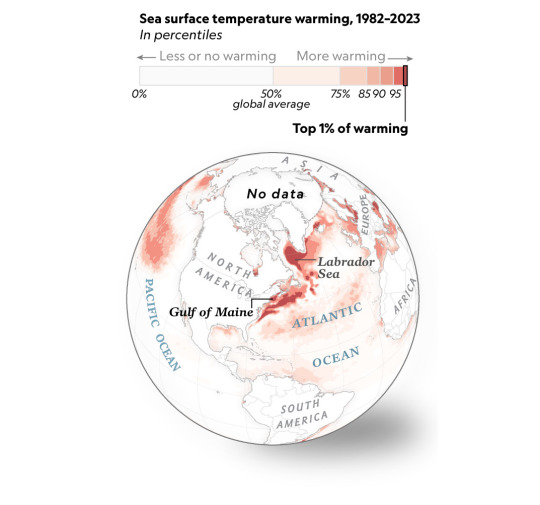
Why The Gulf Is Warming So Fast: The Gulf of Maine resembles a deep tub, its shallow banks inundated by cold Arctic waters. But melting fresh-water glaciers and other effects of climate change are altering long-established currents, according to the Gulf of Maine Research Institute, causing temperatures to warm three times as fast as other ocean waters.
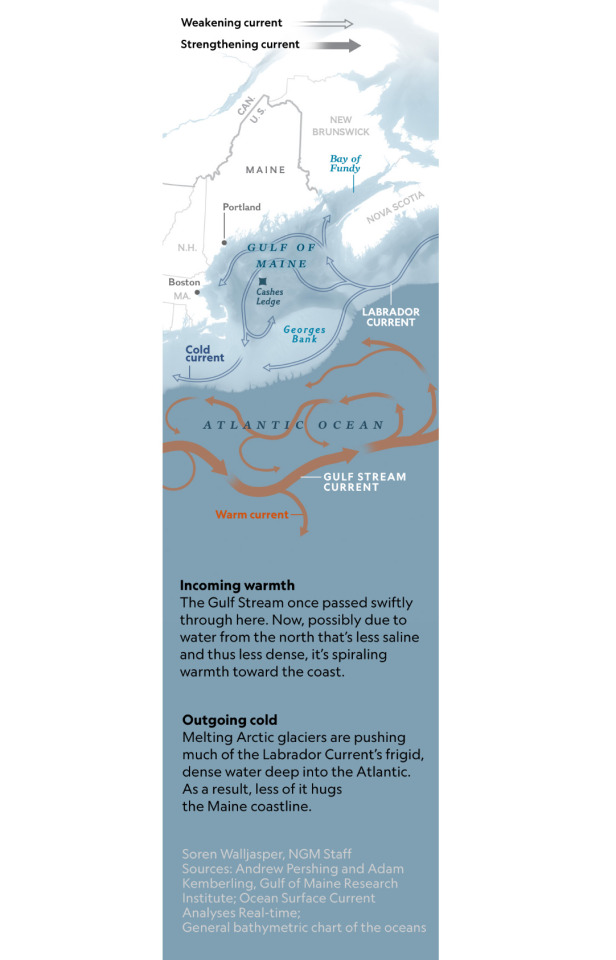
Years ago, I moved to the coast of Maine to more frequently explore these waters. In doing so, I saw signs of a looming threat. People in marine science and conservation communities had grown alarmed after reading a 2015 paper by Andrew Pershing (1), then chief scientific officer at the Gulf of Maine Research Institute. Within a few years, it became common knowledge among locals that the Gulf of Maine was warming faster than 99 percent of the world’s oceans.
— (1) Pershing’s report, “Slow Adaptation in the Face of Rapid Warming Leads to Collapse of the Gulf of Maine Cod Fishery,” sparked research that shows how these waters have continued warming at an alarming rate.
I now felt an urgency to share the wonder of my native waters—to focus on the beautiful wildlife that remains while highlighting the effects of climate change. To get it right, to make sure my images were representative of that change and its enormous impact on the region, I contacted many scientists and experts who have spent decades studying the gulf.
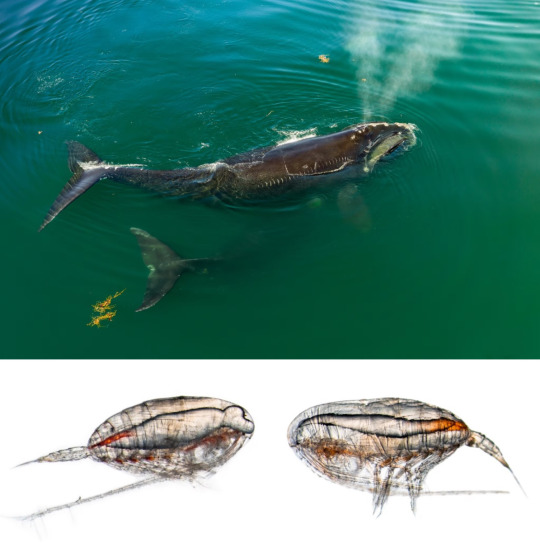
Top: Rare North Atlantic right whales glide through Cape Cod Bay in Massachusetts. These whales, some of the most endangered in the world, feed primarily on tiny creatures called copepods. As water temperatures rise, copepods have become leaner, imperiling the whales and larval lobsters that depend on them.
Bottom: These copepods, Calanus, are the main source of food for the endangered North Atlantic right whale and larval lobsters. When the copepods descend into deep waters to hibernate, they typically store 70% or more lipids (left). With rising water temperatures throughout the year, they don’t need as much fat to survive and in turn are skinnier (right). This means larval lobsters and right whales may not be getting enough nutrients year over year.
My original plan was to visit the most spectacular locations I had dived in decades past—places like Eastport, Maine, where the extreme tides of Passamaquoddy Bay exchange water and nutrients multiple times a day. I remembered Eastport as a cold-water kaleidoscope of fish species and invertebrates that could be seen easily just by making a dive from the beach. But when I got there, it was like a ghost town. The abundance of life that I had seen before was gone. Where exotic-looking creatures once carpeted the bottom, now there was only mud. Water temperatures were noticeably warmer.
The singular mix of elements that made the Gulf of Maine a fertile oasis is the reason it is now warming faster than almost anywhere else. These waters are also a harbinger for what the rest of the world might see. According to Charles Tilburg (2), an oceanographer and the director of marine and environmental programs at the University of New England, the gulf works “like a bathtub: If you turn down the cold water and turn up the hot water, the bathtub’s going to get warmer.” Tilburg has spent about 15 years tracking how the frigid Labrador Current is weakening, providing less cold water to the gulf, while the hotter Gulf Stream is shifting slightly north and adding warmer water to the region.
— (2) More than 60 rivers flow into the Gulf of Maine, adding water that is on average warmer than the ocean, Tilburg explains. Meanwhile, the region’s relatively shallow waters also absorb atmospheric heat.
But despite the collective stresses of overfishing and climate change, there are some species that have benefited, if only temporarily.
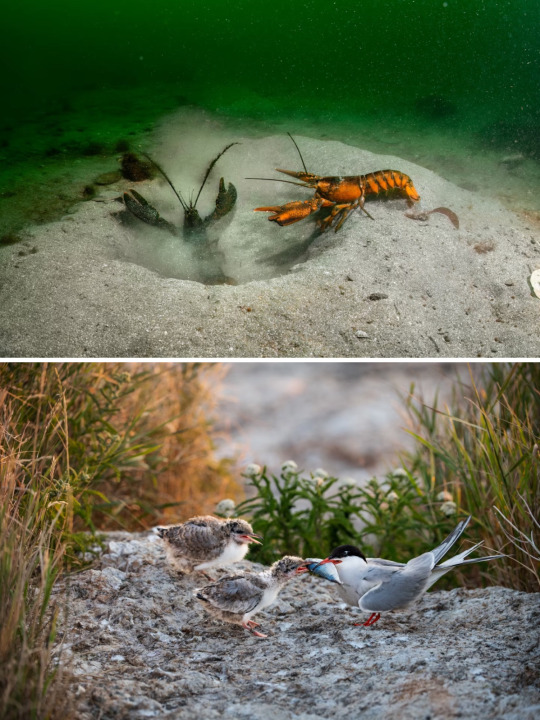
Top: Two lobsters fight over a burrow near the Isles of Shoals.The species has been booming, and typical rocky shelters—where lobster predators also lurk—are becoming overcrowded.
Bottom: A common tern tries to feed its chick a butterfish, but the offering is too wide to swallow. Butterfish now outnumber the slender silverfish that terns favor, such as herring and sand lance.
So far, temperatures in the Gulf of Maine have stayed suitable for lobster reproduction—the lobster-fishing industry appears to be flourishing. But scientists have identified some troubling changes. When temperatures rise to more than 73 degrees Fahrenheit near the coast, female lobsters stay farther offshore, where offspring they release might not intersect with currents that can carry them to the food sources and habitats that are more conducive to survival. These so-called larval lobsters eat zooplankton. Their preferred prey is Calanus, a two-to-three-millimeter copepod that is made up of mostly fat to sustain them through the winter. David Fields (3), a professor of oceanography at Bigelow Laboratory for Ocean Sciences, calls it “the French butter of copepods,” good for bulking up little lobsters.
— (3) Fields has found that copepods are 73 percent lipids, providing critical nutrition for the animals that eat them. These zooplankton are crucial to the survival of not just lobsters; they’re the primary food for endangered North Atlantic right whales.
As the water warms, Calanus copepods no longer need as much fat and grow smaller. That means the baby lobsters lose out on nutrition. Additionally, the warming water has shifted the Calanus’s migration period, which is putting it out of sync with the release of larval lobsters. So even though female lobsters are producing the same number of eggs as before, fewer are surviving into adulthood. In 2023, Maine saw the lowest lobster haul in 15 years, mimicking what’s been happening off the coasts of New York, Connecticut, and Rhode Island.
There’s more bad news for lobsters. The same carbon emissions behind climate change affect not only the ocean’s temperature but also its chemistry. The water is becoming more acidic. Fields says anything with a calcium exoskeleton or chitinous shell, from coral reefs to copepods, can get eroded by such acidification. It could potentially threaten a young lobster’s fragile exoskeleton in 10 or 20 years.
Other disturbing trends have surfaced. Win Watson (4), a marine biologist and emeritus professor at the University of New Hampshire, has studied the changing pH that may endanger lobsters’ ability to smell. That could make it harder for them to find food, detect predators, or sense each other’s pheromones during mating season, which has already gotten more difficult because female lobsters prefer colder temperatures, while males are fine in warmer water. Mates are literally drifting apart.
— (4) Watson has published dozens of scientific papers about lobster biology. Over the years, his research group used ultrasonic tracking, underwater video, and acoustic monitoring to study how lobsters move across the ocean floor and communicate with one another.
On this ocean planet, what happens underwater clearly has consequences on land. For example, the changes occurring with fish populations in the Gulf of Maine are having a direct impact on seabirds. Tern parents see silver fish reflecting sunlight in the ocean and bring them back to their chicks. When parents hunt their typical prey, such as hake or herring, the hatchlings can swallow these slender, silver fish easily. But as the water warms, terns can choose their prey from a larger range of silver fish such as the wider-bodied butterfish, which have shifted north from the mid-Atlantic.
Though some adult birds still find appropriate prey, to many, a silver fish may simply be a silver fish. Elizabeth Craig (5), director of seabird research at the Shoals Marine Laboratory, which is largely funded by the New Hampshire Fish and Game Department, has found that the chicks are unable to swallow the butterfish. They’re not getting enough food, and many remain smaller and either die before they leave the nest or are too weak to migrate.
— (5) Craig recently published a paper showing how butterfish migration, because of warming oceans, appears to be having an impact on tern chick survival: Nearly 80 percent of the butterfish delivered to chicks by their parents don’t get eaten.
It’s a poignant reinforcement of what we already know: Ocean ecosystems are in decline. I’m seeing dramatic ecological changes that should take millions of years, and yet they’re happening in my lifetime. But there are success stories. Plenty of evidence shows that when we permanently protect places in the ocean, remove obstacles, and give marine life a chance, nature finds a way: It is resilient, and it can heal. But nature needs a little help.

Among the marvels that still exist within the Gulf of Maine are gray seals. One approached photographer Brian Skerry with wide-eyed curiosity during a recent dive at the Isles of Shoals.
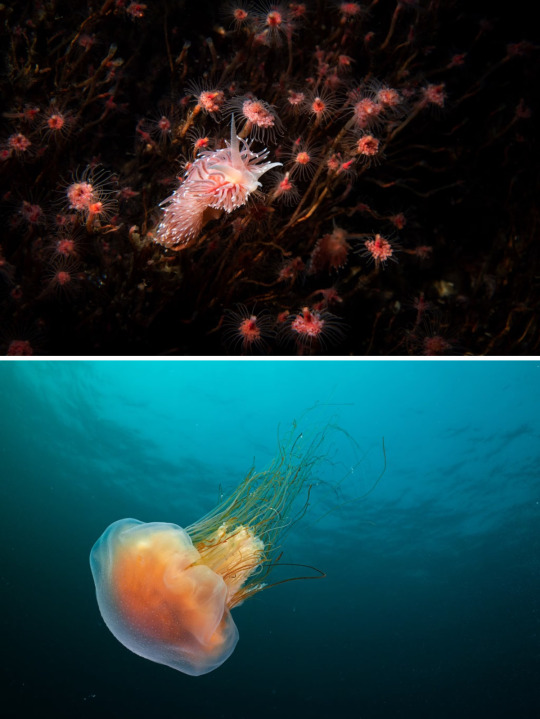
On other dives in the region, Skerry encountered wondrous creatures, including a species of filamentous nudibranch, or sea slug (Top) and this bioluminescent lion’s mane jellyfish (Bottom).
The Alewife Is One Story of Hope In The Gulf Of Maine. This species of fish is an important source of protein for many animals as it migrates from the freshwater ponds where it spawns to the ocean and then back again. In the ocean and in estuaries, where rivers flow into the sea, alewives are eaten by other fish and by birds such as eagles, ospreys, and cormorants. As they migrate into streams in the forest, they can become food for animals such as raccoons and foxes. Finally arriving at their spawning ponds, they must avoid predators like freshwater bass. Survivors of this gauntlet go back to the ocean, with their fry following a few months later.
Alewives had virtually disappeared from the gulf because dams kept them from migrating. The removal of dams in key rivers such as the Penobscot and Presumpscot, done largely in hopes of restoring Atlantic salmon populations, resulted in the revival of the alewife’s ancient migratory route; runs of fish in the millions now occur every spring. One beautiful experience I’ve had in recent years was photographing alewives at the base of a waterfall in Mill Brook Preserve, a tributary of the Presumpscot. The fish gather there to rest before going up the falls. Lying with my camera in only two feet of water, I was surrounded by thousands of alewives swirling around me, the way I imagine the river would have been long ago.
Perhaps the most special place I have explored in this region is Cashes Ledge, a unique underwater mountain range in the middle of the Gulf of Maine. Jon Witman (6), a marine ecologist at Brown University, calls it a time machine to when the gulf was packed with marine life.
— (6) Witman is the lead scientist on the effort to achieve permanent conservation protection for Cashes Ledge, in partnership with Conservation Law Foundation.
As Witman has documented, Cashes has one of every kind of offshore or subtidal marine habitat that exists off the coast of New England, with species rarely seen elsewhere. Because of the ledge’s submerged rocky ridges, waves and currents push large amounts of plankton to the creatures that eat it; Witman says it’s like a food elevator.
In order for climate stability to even be possible, researchers say, we need to protect a minimum of 30 percent of key habitats in the ocean. Today only about 8 percent are formally protected. For Witman, who has been studying Cashes since the 1970s, designating the area as a marine sanctuary feels more urgent than ever. By protecting it, we would help ensure healthy fishery stocks in the future. The fish biomass in Cashes is 300 times that on the coast; animals that live there obviously don’t just stay in one place, so they propagate and spill over.
Cashes also contains the largest kelp forest off the coast of the eastern United States. That’s important because kelp serves as both the base of the food chain and a distinct ecosystem. As a diver, I’ve marveled at the vastness of this amber- and crimson-colored forest swaying so far beneath the surface. For his part, Witman compares the underwater journey to Cashes to a drive through the plains of Iowa for hundreds of miles and coming across a huge mountain with a forest. And like the woods on land, kelp forests capture carbon. The ocean is the greatest carbon sink on our planet, and its phytoplankton give us every other breath that we draw.
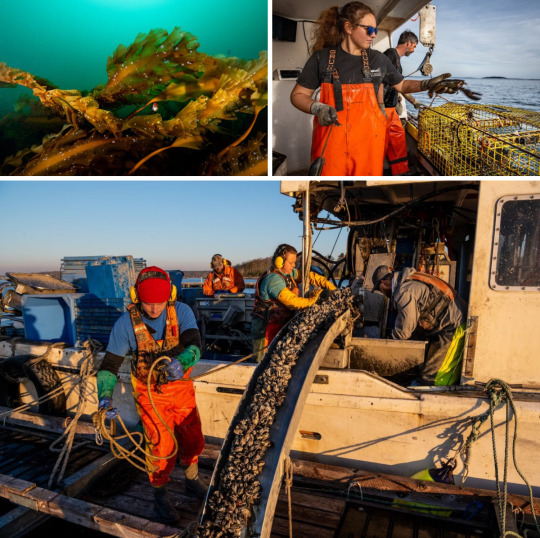
Top Left: A cunner hovers amid several large kelp fronds at Cashes Ledge, a marine area that researchers have identified as a vital sanctuary and hedge against climate change. Cashes’s kelp forest, which supports marine life while absorbing carbon from the ocean, is the largest off the coast of the eastern United States.
Top Right: Seafood harvesters with Bangs Islands Mussels have been raising blue mussels in Maine’s Casco Bay for more than a decade. The mollusks are grown on vertical lines that are attached to a raft and can be winched up for cleaning and sorting. Only those of a certain—larger—size are kept for sale, while the rest are returned to the water.
Bottom: Seafood harvesters with Bangs Islands Mussels have been raising blue mussels in Maine’s Casco Bay for more than a decade. The mollusks are grown on vertical lines that are attached to a raft and can be winched up for cleaning and sorting. Only those of a certain—larger—size are kept for sale, while the rest are returned to the water.
Exactly how big a role kelp plays in that process is being studied by scientists like Douglas Rasher (7) of Bigelow Laboratory for Ocean Sciences. He has spent nearly 10 years studying coastal kelp forests from the southern tip of Maine to its northern borders with Canada and documented their steady decline.
— (7) Rasher has found that warming seawater temperatures result in an invasive red “turf” that replaces habitats as kelp dwindles. This kind of underwater deforestation destroys healthy ecosystems.
Rasher’s research also shows just how fast things continue to change. He’s seen some study sites shift from a forested to deforested state in the span of a five-year research grant.
One Of The Ways Fishers have sought to mitigate potential economic damage from native species decline is by transitioning into new and sustainable ventures. Colleen Francke grew up on Cape Cod inspired by women in the fishing business. After a back injury ended her 10-year lobstering career, she launched Summit Point Seafood to grow kelp, which has a lower cost barrier than mussels or oysters. Francke submerges long lines seeded with kelp in the fall, then in spring sells the harvest to companies that make products like veggie burgers or that use the superfood to provide nutrients and a salt alternative to traditionally kelp-free fare like bread.
Another operation, Bangs Island Mussels, a family business in Casco Bay off the coast of Portland, farms kelp in conjunction with growing mussels. The company uses a method known as integrated multitrophic aquaculture, which allows these two species to grow in harmony with each other. It has a series of large rafts offshore equipped with vertical lines seeded with mussel spat—the scientific term for tiny juveniles—that will mature and be harvested for sale to restaurant wholesalers and distributors. Going out on the water with the Bangs Island harvesters was like watching craftspeople create something beautiful with their hands. The operations produce a renewable resource that may actually be beneficial to the environment.
Co-owner and CEO Matt Moretti is concerned that it will become harder for mussels to survive long enough to grow their shells in the wild because of ocean acidification. Bangs Island Mussels is developing nursery technology at its indoor facility for baby mussels, so that they have the best chance of surviving their vulnerable pre-shell period. Mussels can grow in captivity until their exteriors are thick enough to handle a more acidic ocean.
Meanwhile, some fishers are diversifying by looking to create new markets for species that have not traditionally been commercially harvested. A couple of my neighbors, Sam Sewall and Mike Masi, have teamed up to build a green crab business called Shell+Claw. Green crabs, an invasive species, live mostly in estuaries.
Green crabs were introduced into the Gulf of Maine in the 1800s, brought in by the ballast water of ships. Until recently, their population was kept in check because of the cold winters, but with climate change yielding milder temperatures, their numbers have exploded. They dig into the mud and cut off the roots of eelgrass, which captures nitrogen and carbon and acts as a nursery for estuarine species, and smooth cordgrass, which critically stabilizes riverbanks and fights erosion.
Green crabs also eat clams, historically the second or third most valuable fishery in Maine. Shell+Claw’s business idea is to mitigate the damage caused by green crabs while creating another source of income for its partners who are willing to experiment. Working with researchers, Masi has started to figure out when the crabs molt, thus becoming soft-shell crabs that are edible. The goal is to mimic what’s being done in Venice, Italy, where a similar type of crab is sold as a delicacy. Masi, a former marine biology teacher at the local high school, says harvesting these crabs is probably always going to be a supplemental business for fishers. But clam prices are at their lowest when green crabs are molting in late spring, so the venture can dovetail economically and give clams a chance to recover their population.
When the shedding begins, Masi and Sewall—a 27-year-old former student of Masi’s and fourth-generation lobsterman—immediately take the soft-shell green crabs to high-end seafood places in Boston and Portsmouth, New Hampshire, that are paying a premium to fry them up as sliders or tempura.
So perhaps there is hope for the Gulf of Maine. As I continue to explore these waters, I am troubled by much that I see; the warning signs mirror obvious trends in scientific data. I often think about what the Native tribes—the Wampanoag, Abenaki, Passamaquoddy, and Mi’kmaq—must have seen long ago, and I dream about traveling back in time, hundreds of years, to dive in those waters teeming with life.
Although we have lost so much over the centuries and are facing serious threats today, I still find magic in the Gulf of Maine. My hope is that, armed with the knowledge of the past and the science of today, we can save what remains. And allow it to rebound.
— An Explorer since 2014, Brian Skerry first dived in the Gulf of Maine more than 40 years ago. In this issue, he shares how the area has become a harbinger of climate change. Skerry has contributed more than 30 features to the magazine. His last story was “Secrets of the Whales” in 2021, which accompanied the Emmy Award–winning documentary series that he produced. It’s available to stream on Disney+.
#Environment#Oceans 🌊 | Climate Change | American 🇺🇸 Lobster 🦞🦞🦞 | Whales 🐳 🐋#Ocean Life | Underwater Photography| Wildlife Photography#Water 💧 💦 Pollution#National Geographic
0 notes
Text
Climate of New Hampshire

See Weather Forecast for New Hampshire today: https://weatherusa.app/new-hampshire
See more: https://edition.cnn.com/2024/05/03/weather/brazil-rain-floods-intl/index.html?iid=cnn_buildContentRecirc_end_recirc
New Hampshire, located in the northeastern United States, experiences a varied climate influenced by its proximity to the Atlantic Ocean and its terrain. Summers are generally warm and humid, while winters are cold and snowy. The state's climate is categorized as humid continental, with distinct four seasons.
During the summer months, which typically span from June to August, temperatures in New Hampshire can range from mild to hot. Daytime highs often reach into the 80s Fahrenheit (around 27 to 32°C), occasionally exceeding 90°F (32°C) during heatwaves. Humidity levels can be relatively high, especially in July and August, but the presence of lakes and rivers provides opportunities for outdoor recreation and relief from the heat.
Fall, from September to November, is a spectacular season in New Hampshire, known for its vibrant foliage as the leaves change color. Temperatures gradually decrease, with daytime highs ranging from the upper 50s to the 70s Fahrenheit (around 15 to 25°C). Crisp, cool evenings contribute to the beauty of the autumn landscape, making it a popular time for leaf-peeping and outdoor activities.
See more: https://weatherusa.app/zip-code/weather-03269
https://weatherusa.app/zip-code/weather-03266
https://weatherusa.app/zip-code/weather-03261
https://weatherusa.app/zip-code/weather-03260
Winter in New Hampshire, lasting from December to February, is characterized by cold temperatures and ample snowfall, particularly in the mountainous regions. Daytime highs typically range from the 20s to the 30s Fahrenheit (around -6 to -1°C), while nighttime lows can plummet below freezing, often into the single digits Fahrenheit (around -15 to -10°C). Snowstorms are common, and snow accumulations contribute to skiing, snowboarding, and other winter sports enjoyed in the state's numerous ski resorts.
Spring, from March to May, brings a gradual thaw and the return of warmer temperatures to New Hampshire. Daytime highs slowly climb from the 40s to the 60s Fahrenheit (around 4 to 20°C), signaling the start of the growing season. However, spring also brings the possibility of rain showers and occasional snowstorms, particularly in March and early April.
Overall, New Hampshire's climate offers residents and visitors the opportunity to enjoy a wide range of outdoor activities throughout the year, from skiing and snowmobiling in the winter to hiking, fishing, and leaf-peeping in the summer and fall.
New Hampshire boasts five primary drainage basins, each contributing to its diverse waterways and landscapes. The largest basin belongs to the Merrimack River, located in the central region of the state. Following closely is the Connecticut River basin, situated along the western border. Additional waters flow into the Saco, Piscataqua, and Androscoggin rivers, collectively referred to as the coastal rivers, alongside various smaller streams.
See more: https://weatherusa.app/zip-code/weather-03257
https://weatherusa.app/zip-code/weather-03251
https://weatherusa.app/zip-code/weather-03246
https://weatherusa.app/zip-code/weather-03241
While these riverbanks harbor rich deposits of deep soil conducive to agriculture, the state's overall soil composition tends to be rocky, thin, and challenging for farming. Nonetheless, the rivers serve as vital arteries, shaping New Hampshire's geography and providing essential resources for its communities.
New Hampshire exhibits a highly varied climate, with distinct seasonal characteristics. Winters can be bitterly cold, with temperatures plunging below 0 °F (-18 °C) for extended periods. Summers, on the other hand, tend to be relatively cool, contributing to an average annual temperature of about 44 °F (7 °C).
Annual precipitation in New Hampshire averages around 42 inches (1,070 mm), distributed fairly evenly across the four seasons. Snowfall is a notable feature, with an average of about 50 inches (1,270 mm) along the coast and double that amount, approximately 100 inches (2,540 mm), in the northern and western regions of the state.
The most extreme climatic conditions can be found atop Mount Washington, home to a renowned weather observatory. On April 12, 1934, this summit recorded a world-record wind speed of 231 miles (372 km) per hour, highlighting the remarkable weather phenomena experienced in this region.
See more: https://weatherusa.app/zip-code/weather-03101
https://weatherusa.app/zip-code/weather-03105
0 notes
Text

Boat ride- Piscataqua River, Portsmouth, NH
0 notes